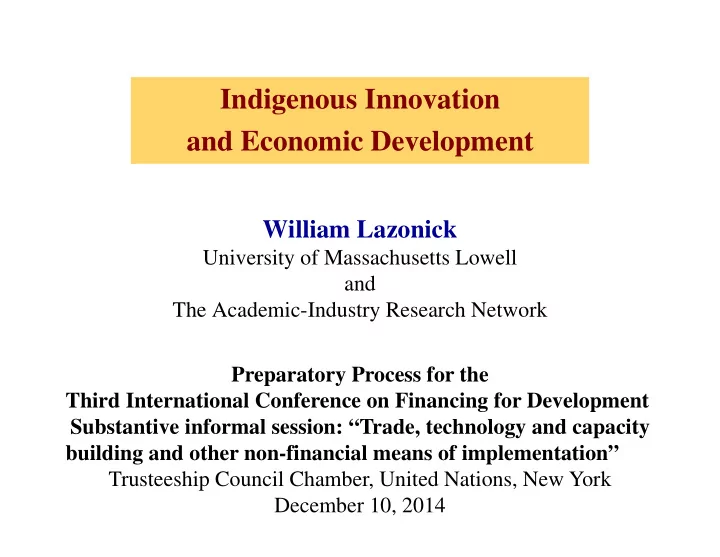

Indigenous Innovation and Economic Development William Lazonick University of Massachusetts Lowell and The Academic-Industry Research Network Preparatory Process for the Third International Conference on Financing for Development Substantive informal session: “Trade, technology and capacity building and other non-financial means of implementation” Trusteeship Council Chamber, United Nations, New York December 10, 2014
Fostering science, technology, and innovation GUIDING QUESTIONS • What has been the progress and what are the remaining gaps in innovation and technological capabilities in developing countries, and what policy actions are needed to address them? • Specifically, what is required to mobilize long ‐ term and patient capital required to finance innovation? A CONCEPTUAL GUIDE TO ANSWERING THESE QUESTIONS • We need • Conventional economic analysis offers only a theory of the optimizing, or” un ‐ innovating” (unproductive), firm • As a result, most analyses of “economic development” focus only on “states and markets”, making it impossible to understand the process of economic development
Innovative enterprise drives economic development • The innovative enterprise is not just an “entrepreneur” . • Innovation is uncertain, collective, and cumulative o Uncertain: if we knew how to generate high ‐ quality, low ‐ cost (i.e., competitive) products, the process would not be innovation o Collective: The essence of innovation is learning by large numbers of people in a hierarchical and functional division of labor o Cumulative: If we cannot innovate all alone, we also cannot innovate all at once
Social conditions of innovative enterprise : a set of relations that gives decision- makers the power to allocate the firm’s resources to confront by transforming technologies and markets to generate higher quality, lower cost products : a set of relations that create incentives for people to apply their skills and efforts to engage in learning : a set of relations that secure the allocation of money to sustain the innovation process until it generates competitive products
Indigenous Innovation • A developing nation transfers technology from abroad via: • employment with MNCs at home • joint ventures with MNCs • upgrading along global value chains • reverse migration of nations with work experience abroad • Through strategic control, organizational integration, and financial commitment transferred technology can be improved to result in indigenous innovation • Strategic control: to engage in higher value ‐ added activities that have been dominated by MNCs • Organizational integration: to invest in collective and cumulative learning that is the essence of innovation • Financial commitment: to sustain the innovation process until it can generate competitive products
Indigenous innovation in China Pioneering study of China’s emerging ICT sector, published in 2000 by the late Qiwen Lu Studies of Stone Group, Legend Computer (Lenovo), Founder Group, China Great Wall Computer Applied the theory of innovative enterprise to Chinese development Summary in W. Lazonick, “Indigenous Innovation and Economic Development,” Industry & Innovation , 11, 4, 2004). Lazonick & Li, “China’s Path to Indigenous Innovation” in progress
Developm ental State • For the sake of innovation, government does much more than provide subsidies and tax breaks • It invests in physical infrastructure: transportation, communication, energy, materials • It invests in the knowledge base: education and research, including sophisticated science & engineering capabilities • The most formidable developmental state in history? • In terms of S&T, USA was Japan’s developmental state • Japan’s own developmental state was critical in finance: Bank of Japan overloans and the Fiscal Investment and Loan Program, funded by the Postal Savings System • South Korea: went further than Japan building up the S&T capability in order to catch up • China: S&T infrastructure and China Development Bank
Interaction of the developm ental state and the innovative enterprise • Strategic control: Essential for the innovative enterprise to have autonomy in strategic decision ‐ making even as it receives essential state support through investments in infrastructure and the knowledge base – while supporting value creation in innovative enterprises the state must regulate value extraction through financial markets • Organizational integration: need a higher education system to enable “collective and cumulative careers”, and need government ‐ business cooperation to provide the types of employment opportunities to sustain these careers • Financial commitment: “retain ‐ and ‐ reinvest”, not “downsize ‐ and ‐ distribute” – state development banks, recognition that the role of financial markets is to extract, not create, value
Organizations and m arkets T he history of capitalist development since the time of Adam Smith shows that well ‐ developed markets are the result, not the cause, of economic development. Labor markets provide wide choices of well ‐ paid jobs when • there are innovative enterprises that can productively employ people by generating competitive products Financial markets provide high yields on a sustainable basis • when there are innovative enterprises generating competitive products Product markets provide an array of goods and services that • are always readily available when there are innovative enterprises generating competitive products
Organizations and m arkets Organizations (government agencies, business • enterprises, family households) invest in the collective and cumulative learning that results in well ‐ developed markets. Markets facilitate the interactions among these • economic actors. But if markets in labor, finance, and products are unregulated, the results will be income inequity, employment instability, and a decline in innovative capability.* * For the case of the U.S., see Lazonick, “Profits Without Prosperity: Stock Buybacks Manipulate the Market and Leave Most Americans Worse Off ,” Harvard Business Review , September 2014.
Recommend
More recommend